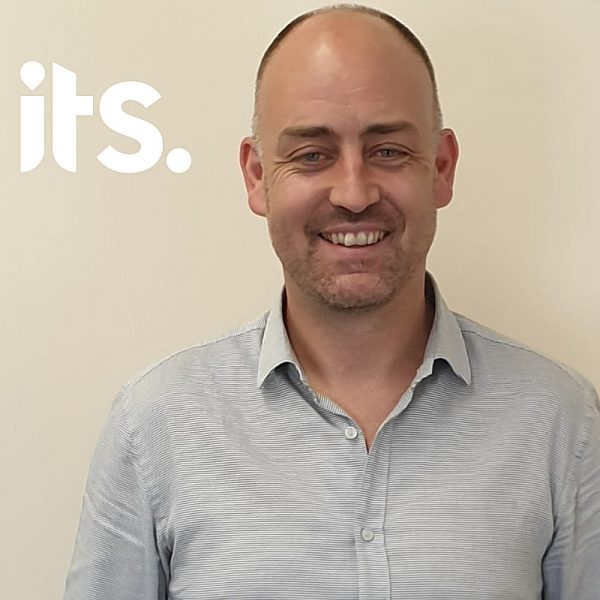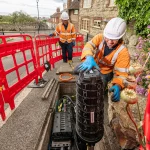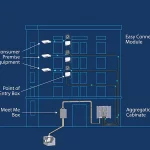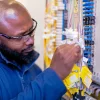ITS Technology – Opportunity and Threat from UK Copper Switch Off

The CEO of UK ISP ITS Technology, Daren Baythorpe, has told ISPreview.co.uk in a new interview that the UK’s push to switch-off old copper line broadband networks in favour of Gigabit speed “full fibre” (FTTP) presents both “opportunity and threat,” not least from the risk of enabling Openreach to “recreate a monopoly.”
At present ITS runs 24 alternative full fibre and hybrid (wireless and fibre) networks across the United Kingdom and their current contracts enable access to more than 70,000 premises, which primarily reflects business connections but they also serve a few residential properties in nearby areas.
The provider has just spent the last 18 months transforming and restructuring itself ready for further growth, which among other things has involved upgrading some of their smaller hybrid networks whilst also developing and building out their existing and new full fibre infrastructure.
Advertisement
As part of the above effort the ITS Technology Group last year appointed the former MD of Openreach’s (BT) Business and Corporate Delivery, Daren Baythorpe, to become its new CEO. The new boss says he supports the current government’s drive to achieve universal “full fibre” coverage via targeted investments, business rates relief on new fibre (although he wants this to last longer than 5 years), a softening of regulation and connectivity vouchers etc.
However Daren also believes that the current government could go further and should look at “smart alternative financial models,” which he says might allow for investment in innovative commercial schemes, such as asset sharing etc. Admittedly organising this at scale and across lots of different networks could be tricky.
Furthermore Daren told us that the planned copper switch-off and gradual migration to full fibre presents both “opportunity and threat.” In particular he warns that his former employer, Openreach, could use its “scale and go to market capabilities to try to recreate a monopoly.” On the other hand he says there’s a “greater opportunity and place for all as agile altnets continue to accelerate full fibre rollout as copper switches off.”
We touched on all of these issues and more in our short interview below.
Advertisement
The ITS Technology Interview
1. ITS has spent the past few years deploying and acquiring a series of fibre optic and wireless broadband networks across different parts of the United Kingdom. Can you tell us a little about how many networks you have now, as well as how many premises have been covered and customers connected?
ANSWER:
ITS has 24 full fibre and hybrid networks across the UK. During the last few years, we have focused on realigning our business strategy – securing major commercial network agreements and driving a pipeline of strategic growth opportunities.
Our current full fibre major networks contracts and hybrid networks enable access to more than 70,000 premises.
2. Back in 2016 ITS took a huge decision by making your network available via wholesale to other providers. How has that change impacted your business and are some of your networks still being excluded from this (I recall that originally some of your wireless networks in Wales and East Manchester were not included)?
ANSWER:
We have opened up all our full fibre networks and some of our hybrid networks to other providers – all those that connect into our national network. It was absolutely the right decision to take. We are steadily growing this side of the offer as our footprint increases, and it remains one of our key growth strategies.
To underpin our wholesale offer, we have made some key appointments to ensure we have the skills to take this forward. We have particularly focussed on the reseller business, which has grown significantly since a programme restructure and relaunch earlier this year. This shift in strategy has had a positive impact on the business where we have seen circa 30% growth year on year (as of H1 2019).
3. Some of the networks you run appear to serve residential premises too, although finding out precisely what is available to homes, where and how much it costs still seems to be difficult. Can you tell us a little bit more about what sort of services are available to homes, and where?
ANSWER:
Whilst our strategy is focussed on the B2B market, where appropriate and through the right channels, we will deliver and build residential services and infrastructure across a number of locations. This is for three reasons. Firstly, ITS acquired some small providers delivering services on hybrid networks over the course of 2014/15. We have since made significant investment to improve, upgrade and deliver superfast if not gigabit capable services to these often overlooked rural areas.
The second reason is that one of our key aims is to deliver connectivity where it is needed, which includes communities. The result is several new networks have been installed to help communities without fit for purpose connectivity. We don’t believe in leaving anyone digitally excluded, so the makeup of the end-users is a mix of business – for example a pub, a school, village hall etc – and residential premises.
The third reason is because we have developed expertise in delivering connectivity and cloud services to historic country estates. Again, this serves a mixture of business, agricultural and residential properties in hard to reach locations.
Where we have built these networks, we often build out to serve neighbouring communities – a great example of this is in Teesside, where we have long served the Wilton Centre, a science and business park, and have recently built out using a RAN.
4. Do you expect to expand into covering more residential properties in the future or is the plan to keep ITS focused upon business connectivity?
Advertisement
ANSWER:
Our focus remains on our B2B and wholesale propositions. However, should it be appropriate, and if there is demand to serve a mixture of business and residential premises, we will do so with the right channel strategy.
5. Which of your networks would you say has been the biggest and most challenging, and why?
ANSWER:
Every network brings its own challenges; from the commercials to difficult terrain. Being given code powers last year has certainly taken away some of the pain! I am proud of our ‘concession’ and coop networks; the innovative nature of the agreements we have with local authorities, coupled with asset reuse.
Getting specific, a couple of networks spring to mind. The first is a rural full fibre network we delivered against the odds in Littleworth, Buckinghamshire. The second is the full fibre network in Tameside.
Starting with Littleworth Common; this was a village that was completely overlooked and had really struggled to overcome this. Our rural team came up with a design and commercially viable network that is futureproof and capable of connecting the entire village. Having faced and dealt with many hurdles, we took a greenfield site and laid more than 3km of fibre to connect the village including 2 pubs, a village hall, school and residential properties. The villagers have also benefitted from BDUK funding, which shows how valuable these schemes are, particularly in these underserved areas.
The UK-wide Cooperative Network Infrastructure (previously The Digital Infrastructure Cooperative), is a project that really allows us to flex our reuse muscles. We have played a big role in developing a model in Tameside which is now being rolled out across the country, with support from BDUK.
6. The last financial results we saw for ITS, to the end of 2017, noted that the company had net current liabilities of over £800K, net liabilities of £1.586m and a loss before taxation for the year of £3.558m. On top of that the average number of people employed by ITS (inc. directors) during the year was recorded as 33 (down from 45 in 2016).
However it’s not uncommon for infrastructure providers to suffer big losses during a growth period as the cost of deploying such networks is significant. We also understood from the same results that ITS had developed a business plan through to 2023 and continued to enjoy the support of creditors.
Can you give us a hint about what that business plan is and where you expect to be in around 3-4 years’ time?
ANSWER:
Yes, like all other altnets and network providers, there is a certain amount of cash burn while we invest heavily in capital on network assets. We are delighted to have the continued support of our investors.
Our business performance continues to improve year on year, with our current year of trading showing material improvements on last year.
My focus has been on getting the business ready to grow at pace and take advantage of the current exciting market opportunities. We have now transformed the business from a strategic, structural and process perspective, improving service, and making some key appointments. This has ensured that we not only have the right skills to take us forward, but also have the right infrastructure and capability to deliver on our business plan.
Our strategy moving forward is to continue to build on our network footprint and apply our ‘dig once’ approach where we can. However, we expect to move into a faster growth phase moving into 2020.
7. Earlier this year Cityfibre lost a Judicial Review of the UK advertising watchdog’s decision (or at least its interpretation of related research) not to clamp down on ISPs that advertised slower hybrid fibre (FTTC / VDSL2 / Cable etc.) services as “fibre”, “fibre broadband” or “fibre optic broadband” etc.
The operator had wanted only true “full fibre” (FTTP) providers to have the right to use such terminology in their adverts. Do you think the court made the right decision and what would you have done differently, if anything?
ANSWER:
No, I don’t think the court made the right decision. It’s incredibly disappointing and is an issue that as a business we face; particularly since we launched our low contention full fibre broadband service – FibreLight. The misuse of the terms creates confusion, but more important, it is stifling ‘the stimulation’ of growth.
We absolutely support the industry (INCA) view that there must be more clarity. A huge investment was made by CityFibre. Hindsight is always easy, but maybe a more joined up altnet approach might have had more impact and swayed the judgement?
8. A number of alternative “full fibre” (FTTP) network providers (e.g. TalkTalk, Hyperoptic, Cityfibre, Gigaclear and INCA) have called on Ofcom and the Government to take tougher action against Openreach (BT), not least in order to limit their ability to overbuild them and thus hopefully improve overall UK network coverage.
However, nearly all of this battle is currently taking place in urban areas, where commercial competition is natural and often aggressive. Likewise there are advantages to overbuild between rivals, such as a greater a choice of networks / services. On the other hand it can make the market more complicated for both consumers and wholesale ISP clients.
What are your views on this issue and how do you think it should be tackled?
ANSWER:
We recognise that the UK is in a phase of fibre transition and are greatly encouraged by Openreach’s decision to plan for the copper switch off. We are proud to be an altnet building gigabit capable networks during these unprecedented times in the UK; the likes we will not see again.
With regards to competition; our view is that DCMS’ FTIR released in 2018, illustrated that in urban areas at least a third, if not more, would be able to sustain 3 or more competing gigabit capable networks; and up to half of premises are likely to be in areas that can support competition between 2 gigabit capable networks.
Choice and competition are important where the economics of the environment can sustain them. The way to reduce complication is to create open access networks – as we do. Giving service providers flexibility on which networks they can use provides maximum utilisation and optimal competition – and is transparent to the end user. In rural areas a natural monopoly at infrastructure level is likely to continue. We will use our wholesale access approach to provide choice at the retail level wherever possible.
Please flick over to page 2 to continue this interview..
Mark is a professional technology writer, IT consultant and computer engineer from Dorset (England), he also founded ISPreview in 1999 and enjoys analysing the latest telecoms and broadband developments. Find me on X (Twitter), Mastodon, Facebook, BlueSky, Threads.net and Linkedin.
« Consumer ISP Choices on Openreach’s UK FTTP Broadband Network
The Project Using Twitter to Map UK 4G, 5G Mobile Hotspots »






















































Comments are closed